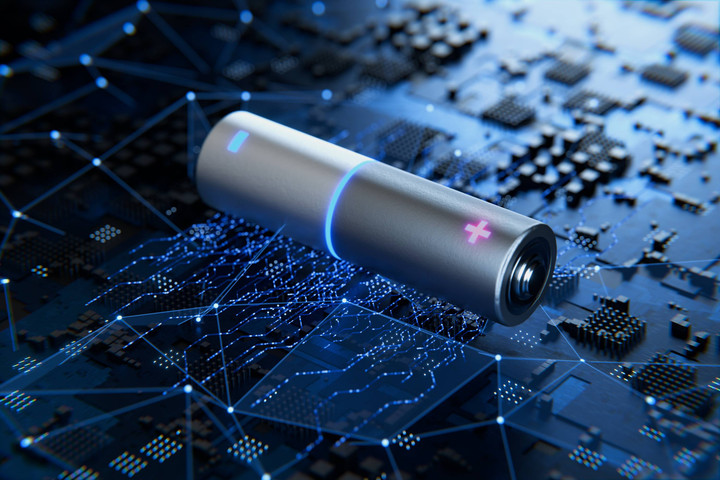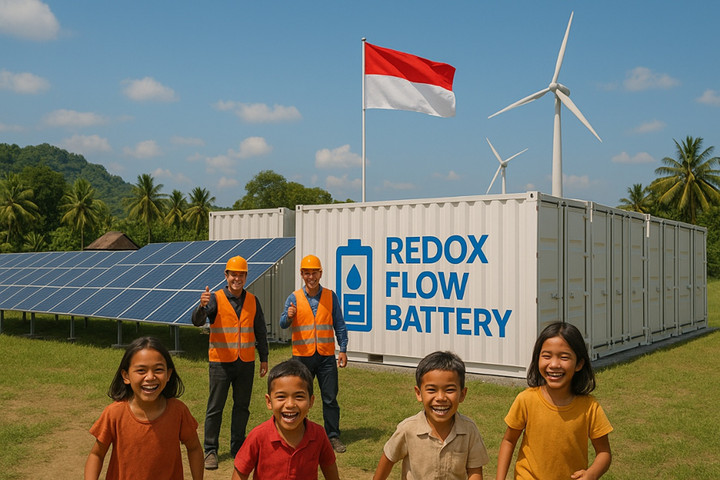Judul : Energy Justice Without Mining for Indonesia: Redox Flow Battery
link : Energy Justice Without Mining for Indonesia: Redox Flow Battery
Energy Justice Without Mining for Indonesia: Redox Flow Battery

Amid Indonesia's vigorous ambition to become a major player in the global electric vehicle battery supply chain, the government continues to push for large-scale expansion of the mining industry, especially nickel, which has recently sparked controversy among various parties. Nickel mines are emerging in Sulawesi and Maluku, but their benefits have not yet been genuinely felt by the local communities. Many residents still live without adequate access to electricity, limited infrastructure, and even face environmental damage caused by uncontrolled mining.
This paradox shows that Indonesia's energy transition is biased: too focused on mining downstream and the development of battery factories based on rare earth metals, yet forgetting about sustainability, energy equity, and appropriate solutions. Especially for remote islands that greatly need access to clean energy.
Lithium and nickel are promising, but their use is most appropriate for private electric vehicles such as electric cars and motorcycles, which are mainly used in urban and industrial areas. Meanwhile, in many remote areas of Indonesia, electricity is still a luxury. According to data from the Directorate General of New Renewable Energy and Energy Conservation (2023), more than 2,300 villages in the 3T areas (underdeveloped, frontier, and remote) still do not have access to proper electricity. On small islands such as in East Nusa Tenggara, Papua, North Maluku, and Talaud Islands, residents still rely on generators or only enjoy electricity for a few hours a day.
With this reality, Indonesia needs to shift the focus of battery development towards first meeting energy equity. If local social and economic aspects are solid, then promoting popular batteries for transportation can become a more appropriate and fair subsequent step.
This is where Redox Flow Battery (RFB) technology emerges as a new hope. These batteries can be ideally integrated with Solar Power Plants (PLTS), becoming a safe, durable, and suitable energy storage solution for island areas not connected to the national power grid.
Great Potential of RFB
Lithium or nickel batteries are indeed popular, but not without problems, especially when applied in remote areas. These types of batteries have a high risk of fire and degradation, especially in hot and humid regions like Indonesia. Moreover, their lifespan is relatively short and expensive to replace or recycle. Furthermore, there is unfair distribution, which we can see from nickel-producing islands that remain energy-poor, while the mined resources are enjoyed in big cities.
On the contrary, RFBs, especially Vanadium Redox Flow Batteries (VRFBs), have become the main focus in the development of large-scale energy storage systems. Some technical advantages supported by recent scientific research include:
-
Durability and Long Service Life
VRFB has a very long cycle life, reaching 15,000 to 20,000 cycles, with an operational life of up to 20-30 years, making it an ideal choice for long-term energy storage. The cycle life refers to the number of charge and discharge cycles of the battery until its capacity drops to a minimum threshold (usually 80%). The longer the cycle life, the longer the battery can be used without replacement, as shown in research from the Journal of Energy Storage (2024), Pacific Northwest National Laboratory (2023), and International Renewable Energy Agency (2022).
-
Operational Security
One of the main advantages of VRFB compared to lithium-ion batteries is its inherent safety characteristics, even under extreme conditions. This is particularly important for remote and tropical regions like Indonesia, where fire suppression systems, early detection tools, and cooling systems are not always available. Interestingly, Pacific Northwest National Laboratory, 2023, refers to VRFB as "one of the safest electrochemical storage systems" because it does not require a thermal management system. Furthermore, in Sumitomo's VRFB system in Hokkaido, Japan, there have never been any fire incidents despite operating for more than 8 years under extreme temperature conditions.
-
Scalability and Design Flexibility
The ability to separate energy capacity and power allows VRFB to be tailored to specific needs, whether for small or large-scale applications. In conventional energy storage systems such as lithium-ion batteries, energy capacity (how much energy can be stored) and power (how quickly energy can be released) are combined within a single cell unit. This means that if we want to increase the energy capacity, we also have to increase the power, and vice versa—costs also rise accordingly. On the other hand, RFB has a different architecture, where power depends on the size and number of electrochemical cell stacks, and energy capacity depends on the volume of liquid electrolyte stored in the external tank. Therefore, we can increase energy capacity (for example, for night-time supply) simply by increasing the tank volume. We can increase the output power (for example, for heavy equipment or hospital machines) simply by increasing the number of stacks, or adjust both according to the needs.
-
Stability in Various Environmental Conditions
One advantage of VRFB compared to conventional battery technology is its thermal endurance. This battery can operate stably at temperatures between -10°C and 50°C, without significant performance degradation or fire risks like those in lithium-ion batteries. A study published in the Journal of Power Sources (Elsevier, 2023) shows that VRFB can maintain a coulombic efficiency of over 95% and an energy efficiency of over 75% within the temperature range of 5–45°C, with very little change in energy density and electrochemical reaction rate. This makes it highly suitable for application in Indonesia, as most areas of Indonesia have average daily air temperatures between 26°C and 34°C, with humidity reaching 70–90%.
-
Maintenance and Recycling Convenience
Unlike lithium-ion batteries that store energy in solid active materials (solid-state electrodes), VRFB stores energy in the form of liquid electrolyte, which circulates outside the cell in an external tank. This design provides unique advantages in terms of maintenance, repair, and recycling. The VRFB electrolyte contains vanadium in four different oxidation states. Unlike lithium, which can become unstable or permanently damaged, the vanadium electrolyte remains chemically intact throughout the battery's lifetime and can be reused even after 20 years of operation. In fact, a study from Sandia National Laboratories (2023) showed that after 10,000 usage cycles, the VRFB electrolyte retains more than 95% of its electrochemical reaction capacity, and only requires simple regeneration without toxic solvents.
Not only theoretically attractive, some countries have already implemented this technology. In October 2022, China launched the world's largest VRFB with a capacity of 400 MWh and power of 100 MW, designed to support the integration of wind and solar energy into the national power grid. Later, Sumitomo Electric built a VRFB facility in Hokkaido with a capacity of 60 MWh and power of 15 MW, which has helped stabilize the local power grid and support the development of 15 new wind farms in the region. Not only in Asia, in May 2025, FlexBase started construction of a technology center that will house a VRFB with a capacity of 1.6 GWh, making it the world's largest VRFB project designed to support grid stability and research on renewable energy technologies.
Technology for Justice in Indonesia

Imagine a solar power plant on islands like Lembata, Wakatobi, or Kecil Kei. With RFB, energy from the sun can be stored in large tanks and used at night or on cloudy days without needing diesel generators or expensive batteries. There are no explosions, no pollution, and no need to replace batteries every five years.
RFB is very suitable as the backbone of the system off-grid microgrid Technology that can strengthen local energy resilience, support education, health, and the local economy.
Instead of merely exporting raw nickel ore or purchasing foreign technology, Indonesia has the opportunity to develop its own RFB industry: from research on local materials (vanadium, iron, and even organic waste as electrolyte), production of tanks and control systems, up to training of energy technicians.
The government and state-owned energy enterprises such as PLN and Pertamina Power can start testing RFB in pilot projects on small islands. BRIN, together with universities in Indonesia, can be encouraged to conduct research and development and technology utilization of RFB. Even cooperation with international partners such as Japan, Australia, or Germany is very possible.
Indonesia is about to settle!
Energy transition is not just about replacing gasoline with batteries, but ensuring every citizen, on every island, has access to clean, safe, and sustainable energy. Redox Flow Battery is a real solution for this. Therefore, if Indonesia wants to write a fair and sustainable energy future, it's time to invest in the right technology, not just chase profits from mines.
Because fair energy starts with electricity that can be enjoyed by all - not just by big cities, but also by villages throughout the land of Indonesia.
Demikianlah Artikel Energy Justice Without Mining for Indonesia: Redox Flow Battery
Anda sekarang membaca artikel Energy Justice Without Mining for Indonesia: Redox Flow Battery dengan alamat link https://www.punyakamu.com/2025/07/energy-justice-without-mining-for.html
0 Response to "Energy Justice Without Mining for Indonesia: Redox Flow Battery"
Post a Comment